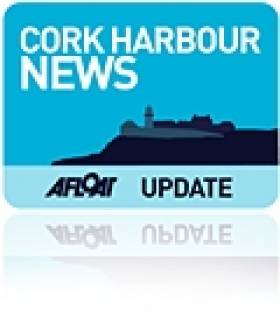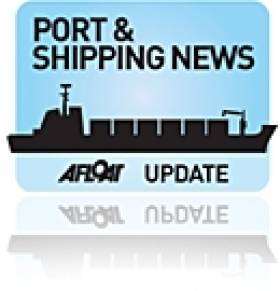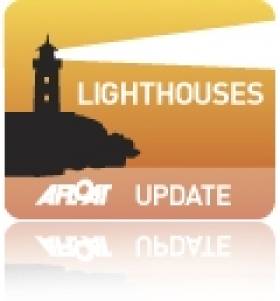Displaying items by tag: Cork Dockyard
#CorkDockyard – Among the shipping seen at Cork Dockyard yesterday was the Naval Service 'flagship' L.E. Eithne (P31) which was berthed in the graving dock, writes Jehan Ashmore.
The Helicopter Patrol Vessel (HPV) is at the shipyard and repair facility where on the same site at a neighbouring slipway she was launched three decades ago from Verolme Cork Dockyard (VCD). She along with L.E. Aoife (P22) and L.E. Aisling (P23) were built by VCD, they were commissioned into service in 1979 and 1980 respectively.
L.E.Eithne represents the last custom built patrol vessel for the Naval Service from that of the VCD yard and notably the last ever ship completed in the republic in 1984. As previously reported on Afloat.ie, as part of last year's The Gathering, a commemoration of Cork's shipybuilding workers and heritage over 160 years was held in Cobh.
Shipbuilding in Cork Harbour has long gone, however on the far side of the Celtic Sea, it is pleasing to note of the third option to build another Naval Service OPV90 class was confirmed by An Taoiseach, Enda Kenny T.D. and Minister for Defence with the same yard of Babcock Marine in north Devon.
The contract of the €54m newbuild follows the class leadship, L.E. Samuel Beckett (P61) and sister L.E. James Joyce currently under construction at the yard in Appledore and due in early 2015.
The third 'playright' OPV90 sister is expected to be delivered into service in 2016.
Cork Harbour Open Weekend & Dockyard Photo Exhibition
#CorkHarbour – Cork Harbour Open Weekend (14-15 September) as previously reported will also include a Harbour Photographic Exhibition of close to 200 photographs covering all aspects of the development of Cork Dockyard, the ships built and repaired.
The Cork Dockyard Ships & Shipbuilding photo exhibition sponsored by the Port of Cork Company was launched last week in advance of the Verolme Workers Gathering Weekend and is currently on view at Cobh Heritage Centre until 15 September.
The photographic display also includes photographs of the shipyard workers tracing the strong local history of shipbuilding in Cork Harbour, which was recognised at a ceremony held last weekend at the former Verolme Cork Dockyard, now the site of a ship-repair only business.
Meanwhile, Cork photographer Robert Bateman whose original work features in the exhibition has published a fascinating gallery online to celebrate the Verolme Workers Gahering weekend. View the gallery here.
#VerolmeWeekend – To mark the finale of Cork Dockyard Workers Gathering Weekend, the last Mayor of Cobh Town Council, John Mulvihill Jnr, attended yesterday a plaque unveiling dedicated to shipyard workers to include Verolme Cork Dockyard in Rushbrooke, writes Jehan Ashmore.
Among the large crowd of former VCD employees, family and friends, was John Brennan who was master of ceremonies at Cork Dockyard, (formely VCD) which is a ship-repair only facility that is part of the Doyle Shipping Group.
Conor Doyle of the Doyle Group spoke of the wonderful history of shipbuilding in Cork Harbour and he said the group remained committed to the dockyard which has the 'potential' for further development should the demands from the offshore energy industry require.
During the proceedings, poetry and song celebrated the lives and workers of shipbuilding yards throughout Cork Harbour in a history that stretches beyond VCD's formation in 1959 but back to 1860.
An anchor was restored recently for the memorial occasion and where a bottle of champagne was smashed against it by Delia Webster of Cobh Tourism.
The Port of Cork, Cork Dockyard, Cobh Tourism and Irish Rail organised the commemorative weekend which involved a shipping lecture programme held in the Commodore Hotel, tours of L.E. Aoife alongside Cobh's waterfront. A mass in St. Colman's Cathedral was held and where a baptismal font was restored by former VCD staff.
Also part of the weekend was a photographic exhibition of ships built at VCD which remains open to the public in the Cobh Heritage Centre until 15 September.
The commemorative plaque was unveiled by Henk Ven der Puil, son of the late Gerard Van Der Puil, Managing Director of VCD. Father Michael Leamey performed a blessing of the plaque..
At its prime VCD employed more than 1,200 people working in ship-building, ship-repair, offshore platform modules and many other engineering enterprises.
During its quarter century existence, VCD built a total of 33 vessels, mostly for Irish concerns, among them Irish Shipping Ltd (ISL), B+I Line (including the last 'Leinster' as previously posted), Arklow Shipping and overseas clients and notably the bulker Irena Dan.
Naval ship LE Niamh in dry dock. Photo: Jehan Ashmore
The first vessel built was Irish Rowan, other ships built for ISL included the 75,000dwt Irish Spruce, a 'Panamax' bulker completed in the early 1970s.
L.E. Eithne (P31) was commissioned as the last vessel out of five built for the Naval Service and indeed she is also the last ever ship to be launched from the Rushbrooke shipyard in 1984.
Following the plaque unveiling, nostalgic tours of the dockyard took place which included access to the large series of building halls, the ship launch slipways and dry-dock / graving dock, where the Naval Service OPV L.E. Niamh (P52) was undergoing an overhaul.
The building halls. Photo: Jehan Ashmore
The remaining cranes. Photo: Jehan Ashmore
#corkharbour – A Cork Harbour photographic exhibition of close to 200 photographs covering all aspects of the development of Cork Dockyard, the ships built and repaired, and the people working there, will be staged at Cobh Heritage Centre until the 15th September.
For over 150 years Cork Harbour and the River Lee has long been associated with both shipping and shipbuilding, with the relationship between Cork Dockyard and Irish Shipping Limited (ISL) dating back to 1941, when a wholly owned subsidiary of ISL was set up by the Dept. of Industry and Commerce (Cork Dockyard Limited) to take over the operation of the dockyard.
In 1946, the Irish Naval Service was established and three "Flower Class" Corvettes began a relationship with Cork Dockyard that has endured to this day and led to the subsequent building of five naval vessels at Rushbrooke.
In 1959, the name of the dockyard changed from Cork Dockyard Ltd, to Verolme Cork Dockyard Ltd which brought the facility onto an international level regarding reputation, quality, expertise, training and of course the arrival of many Dutch families who settled into the Cobh community and to this day are an intrinsic part of the fabric of the area.
At its prime there were over 1,200 people working in Verolme Cork Dockyard, from ship building, ship repair, offshore platform modules and many other engineering enterprises.
Speaking at the official opening of the photograph exhibition in Cobh, Captain Michael McCarthy Commercial Manager Port of Cork said. "Cork Dockyard or the 'Yard' as it was known locally was not only a big employer, but a very important cog in the shipping industry within Cork Harbour. It is important to reflect back to the time when major companies such as Irish Steel, Fords, Dunlop, Whitegate oil refinery and indeed Irish Shipping were located and dependent on the river. In 1984 when Verolme Cork Dockyard, Irish Shipping, Dunlop and Fords all closed this had a devastating effect on the local community and the economy."
He continued: "However, to the great credit of the Verolme Management, the extensive training undertaken by the Company through its trainee, apprentice, technician and Management training schemes and the lifetime skills it imparted, stood many of the workforces in good stead when the dockyard closed in 1984. In fact, I think it is fair to say that the success of the Pharmaceutical and IT Industries in the Cork region benefitted from the training many personnel received at Verolme Cork Dockyard."
According to Michael McCarthy Commercial Manager Port of Cork, he believes that Cork Dockyard has a potentially vibrant future particularly in the offshore oil and gas support role, offshore wind energy and wave and tidal.
He said: "Although it may never return to its former glory days in shipbuilding, I can see its potential in employment for our young people and training prospects. It is still one of the most unique facilities in the country and when we see how Harland and Wolfe capitalised on their asset, it is very important that we keep an open mind on its undoubted potential."
The Cork Dockyard photograph exhibition, which is sponsored by the Port of Cork, will run until 15th September in Cobh Heritage Centre and admission is free.
Ports & Shipping Review: Cruising to the Sun, WWI Warship’s Tourist Role, Stena’s 50th Year, Cargoship Record, Dock Survey of Lighthouse tender and more…
#PORTS & SHIPPING REVIEW - Over the last fortnight Jehan Ashmore has reported from the shipping scene where Irish passengers left wintery conditions by embarking on a cruise directly from Dublin Port which was bound for sunnier climes in Iberia and the Atlantic isles.
A multi-cat workboat, Island Kestral was acquired by Wicklow based Island Shipping, the vessel will be chartered to offshore projects including the renewables industry sector.
Following the fate of the WW1 Battle of Jutland cruiser HMS Caroline, which is to remain in Belfast, the 98-year vessel is to be made into a tourist visitor attraction, likewise of London's HMS Belfast, another veteran but from WW2.
Those considering a career at sea, should take note that the National Maritime College of Ireland (NMCI) is to host a 'Open' Day next Tuesday (23 October) at the campus based in Ringaskiddy.
What's in a name...Stena Line, a household name, but did you realise that the Swedish owned ferry giant derives its name from founder Sten A. Ollsen, and this year celebrates its 50th anniversary. How did the company become to where it is today, operating 19 routes which includes Dun Laoghaire-Holyhead, served by the HSS Stena Explorer, which is to return to the route for 12 days during the festive and new year periods.
While Irish Sea rivals, Irish Ferries is to add a third ferry on to the Dublin Port-Holyhead route also to cover for the festive and new year sailings. The unprecedented transfer of the Isle of Inishmore will join the route's existing tonnage, Ulysses and fast-ferry Jonathan Swift, to provide additional capacity during the busy season.
Those with a strong interest in liners, should head for the London Ship Show next Saturday (27 October). Among the exhibitors are maritime booksellers, artists, model-makers, traders in memorabilia and ephemera postcards. There will be talks about P&O Cruises 175th anniversary 'Grand Event' in the Solent which featured the Arcadia that sailed to Dublin.
A major international conference on Ocean Energy was held in Dublin's Convention Centre and facing opposite the venue, a scientific weather buoy was positioned on the Liffey.
Passengers travelling on ferry routes will be able to have the same travel rights given to those flying or taking the train, when the National Roads Authority is to implement on 18 December.
A record breaking single cargo shipment of 56,000 tonnes of coal, was set in Belfast Harbour, when the bulk-carrier Ocean Breeze docked in the port having sailed from Virginia in the U.S.
Irish Rail which operates Rosslare Europort is to undergo a strategic review, which is predominantly served by the ferry sector, could be transferred to potentially different ownership.
Today the tallship Tenacious is having an 'Open' Day, where the public can board the 65m barque berthed at Sir John Rogersons Quay in Dublins Docklands between 10.00am-12.30pm and 2-4pm.
The hard-working lighthouse tender ILV Granuaile is undergoing a docking survey in Cork Dockyard. The vessel was built in Galati on the River Danube, Romania for the Commissioners of Irish Lights whose headquarters are in Dun Laoghaire, which is the vessel's homeport.
Cork Dockyard Carries Out Docking Survey of Lighthouse Tender
#DOCKING SURVEY– The Commissioners of Irish Lights aids to navigation tender ILV Granuaile (2000/2,625grt) is currently at Cork Dockyard Ltd undergoing her scheduled docking survey, writes Jehan Ashmore.
The tender built in Romania over a decade ago and fitted out in the Netherlands by the Damen Shipyard Group, is required under regulation to drydock twice in five-yearly cycles. Her last docking was in 2009 and the the bouy-laying vessel is due her next scheduled docking in 2014.
Such docking is required by Classification Societies to inspect the underwater areas including hull, propellers, rudders, engine cooling systems, anchors, cables and anti corrosion systems.
At the same time the opportunity is taken to remove marine growth and to apply antifouling paint coatings to the underwater areas and to prepare and paint the ships hull. The principle dimensions of the hull are 79m long on a beam of 15m and with a shallow draft of 4.4m.
She has accommodation for an extra 10 persons or can accept modular housing on the after-deck where navigational aids (bouys) are stowed in cradles. Heavy lifting equipment including a 20 tonne crane with an outreach of 20m is used to position the bouys at pinpoint accuracy using satellite technology. There are 150 offshore buoys which warn mariners of the location of sand banks, reefs, and other offshore hazards near shipping routes.
A helicopter landing deck over the bow is used to transfer maintenance personnel and equipment to certain lighthouses.
ILV Granuaile's homeport is Dun Loaghaire Harbour, where she is seen frequently loading and unloading buoys alongside the various piers. On occasions she enters through the marina to berth alongside the Commissioners headquarters which includes a marine workshop depot facility, though this can only be done on certain tides and for a short duration.
Asides her primary duties serving the lighthouse authority, the vessel is capable of carrying out chain work, search and rescue, salvage and recovery, oil pollution control, towing, hydrographic applications, and ROV work.
The 162 gross tonnes tug had served a career of nearly three decades in Dublin Port, after entering service in 1972. Prior to working in Irish waters the 100ft tug spent the previous decade operating in the UK as Appelsider for Lawson-Batey Tugs Ltd who chartered her to Tyne Tugs Ltd. For historical record and photos click HERE.
In 1998 the Dublin Port Company disposed of the Coliemore alongside her running mate Clontarf (1963/178grt) the former Cluain Tarbh, also built from the same Yorkshire shipyard on the banks of the River Humber.
Initially they were towed to Liverpool but they later appeared at Cork Dockyard in 1999. The Clontarf remained there for a year until she was sold to Barcazas Dominicia SA, Santo Domingo in the Dominican Republic. For photo of the tug in far distant waters click HERE. It was intended Coliemore would follow her Caribbean counterpart but her sale fell-through.
The vessel's ownership eventually transferred to Cork Dockyard where her scrap value will pay for her long-term berthing fees. The tug recently made her final short journey under tow from her berth at the former Verolme Cork Dockyard (VCD) to the facilities slipway where work to break-up the vessel began.
Coliemore and her fleet-mates were given the traditional naming theme of Dublin Bay coastal suburbs spelt in Irish. The naming policy was used by the Dublin Ports & Docks Board (DP&DB) which operated the fleet remained until transferred to the Dublin Port Company established in 1997.
The last tugs to carry the traditional names, Ben Eadar (Howth), Cluain Tarbh (Clontarf) and Deilginis (Dalkey) are now up laid-up awaiting to be sold, to read more click HERE.
Between the 14-16th centuries Dalkey Sound became increasingly important as larger vessels with deeper drafts could no longer enter the port in Dublin due to the dangers of constantly shifting sandbanks and swallow channels in Dublin Bay.
The nearest alternative was for vessels to anchor off Dalkey Island and in the relative shelter of Dalkey Sound where cargoes for the capital where transferred to and fro by lighters to the coastline along Dalkey at Coliemore, which became the principle port for Dublin. Some of the cargo was stored temporally in the medieval castles in Dalkey, otherwise it was directly transported by horse and cart across the plateau to the city.
It was not until the 17th century that the issue of accessing the port of Dublin was resolved, with the completion of the harbour walls that enabled shipping to return on a frequent basis. Captain Bligh of the 'Mutiny on the Bounty' completed mapping Dublin Bay in 1803 which became the most accurate chart at the time and this aided to the safety of mariners.
The fortunes of Dublin's shipping trade increased due to the combination of an easier and safer navigational channel and deeper depths along the quaysides. This led to the eventual demise of shipping using Dalkey. The present-day harbour structure at Coliemore Harbour was constructed in 1868 and is home to a humble fleet of recreational boats and a passenger-ferry service to the island.
- Howth
- Dublin Bay
- Dublin Port
- Clontarf
- Dublin Port Company
- dalkey
- coliemore harbour
- Dalkey Island
- Port of Dublin
- Ports and Shipping News
- Cork Harbour News
- Verolme Cork Dockyard
- VCD
- Dalkey Sound
- Mutiny on the Bounty
- Dublin Port Tugs
- Deilginis
- Captain Bligh
- Dublin port tugs for sale
- Coliemore
- Coliemore tug
- Cork Dockyard
- Cork Dockyard Rushbrooke
- Cluain Tarbh tug
- Ben Eadar tug
- Deilginis tug
- Richard Dunston (Hessle) Yorkshire
- River Humber
- Dublin Ports & Docks Board
- DP & DB
- Cork Dockyard shiprepairers
- Irish shipbuilding







































































